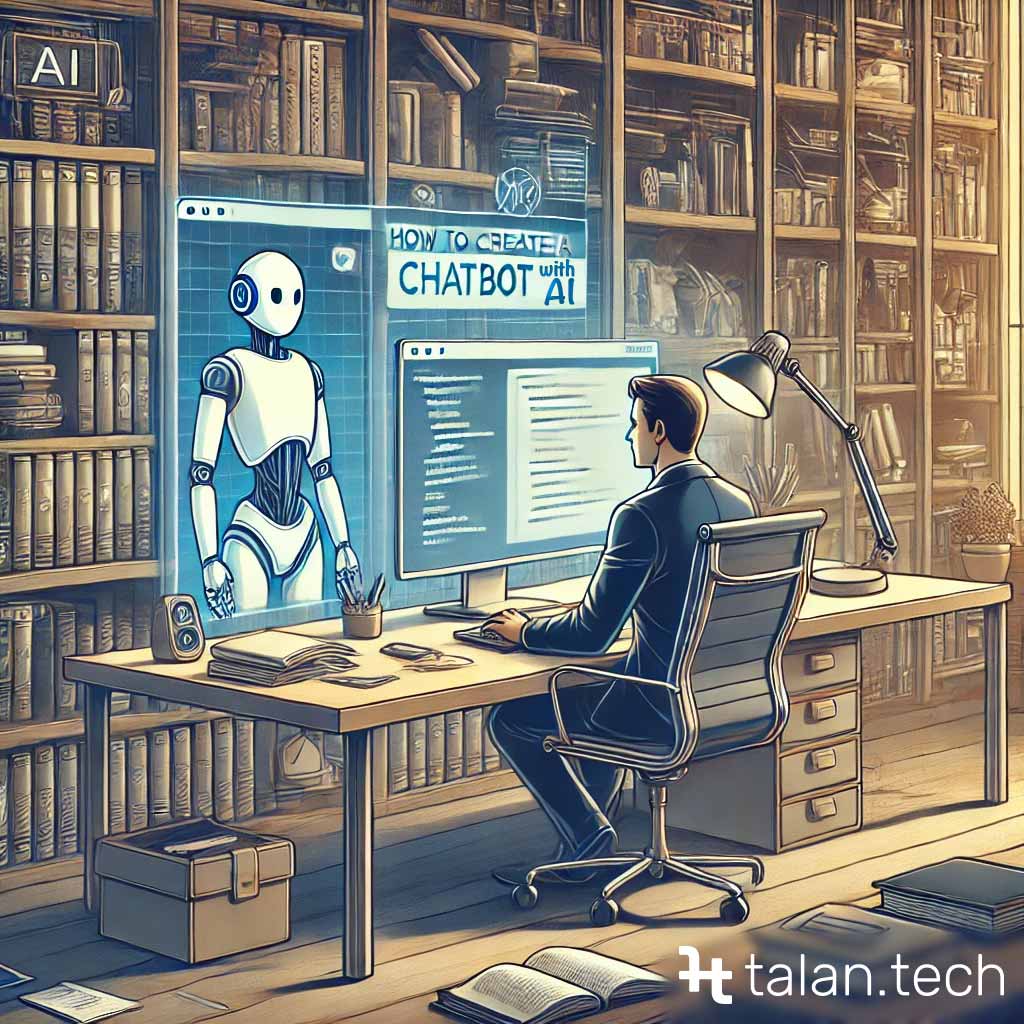Creating a chatbot with AI has become increasingly popular across various industries due to its ability to enhance customer service, streamline operations, and engage users in a personalized manner. This article outlines the steps involved in developing an AI agent, providing a comprehensive guide for those looking to leverage this technology.
What is an AI Chatbot?
An AI chatbot is a software application that uses artificial intelligence to simulate human-like conversations with users. These virtual assistants can understand natural language, process information, and provide relevant responses, making them valuable tools for businesses and developers.
Key Steps to Create an AI Chatbot
Step 1: Define the Purpose and Scope
Before diving into the technical aspects, it’s crucial to define the purpose and scope of your AI agent. Determine what specific tasks your chatbot will perform, such as customer service, personal assistant, or technical support. This will help in selecting the right tools and technologies.
Step 2: Choose the Right Platform and Tools
Selecting the appropriate platform and tools is vital for developing an efficient AI assistant. Popular platforms include:
- Botpress: Botpress is an open-source platform designed for creating highly customizable agents. It offers a modular architecture, allowing developers to add or remove features as needed. Botpress supports multiple languages and can be integrated with various messaging channels, making it a versatile choice for complex chatbot solutions.
- Dialogflow: Developed by Google, Dialogflow is a comprehensive NLP platform that integrates well with various Google services, including Google Cloud. Dialogflow provides pre-built agents and extensive documentation, which can significantly speed up the development process. Its powerful intent recognition and entity extraction capabilities make it suitable for a wide range of applications.
- Langchain: Langchain is a framework that connects language models to other data sources and frameworks. It enhances the functionality of conversational agents by enabling them to interact with databases, APIs, and other external systems. Langchain is particularly useful for creating chatbots that need to perform complex tasks or access real-time information from various sources.
- OpenAI: OpenAI provides powerful GPT models that can be used to create highly interactive and intelligent chatbots. OpenAI’s GPT-4 model, for instance, excels in understanding and generating human-like text, making it ideal for applications that require sophisticated conversational capabilities. OpenAI also offers extensive APIs and developer tools to facilitate the integration of GPT models into various applications.
- Google Gemini: Google’s latest AI technology, Google Gemini, offers advanced features for creating dynamic and responsive products. It utilizes the Gemini Pro language model, which is designed to handle complex language tasks and provide accurate, contextually relevant responses. Google Gemini also supports multimodal interactions, allowing chatbots to process and generate text, images, and audio.
- KoreAI: KoreAI is a robust platform that provides comprehensive tools for building enterprise-grade chatbots. It offers features such as natural language understanding, dialog management, and seamless integration with various enterprise systems. KoreAI’s platform is designed to handle high volumes of interactions, making it suitable for large-scale deployments in sectors like finance, healthcare, and customer service.
Step 3: Set Up the Development Environment
- Install Required Software: Depending on the platform chosen, you might need to install specific software and SDKs. For instance, for Dialogflow, you would set up the Dialogflow SDK and Google Cloud SDK.
- Programming Languages: Python and JavaScript are commonly used languages for developing chatbots due to their extensive libraries and ease of use.
Step 4: Design the Conversation Flow
Designing a natural and intuitive conversation flow is critical. Here’s how to approach it:
- Intents and Entities: Define the intents (what the user wants to do) and entities (specific pieces of information needed to fulfill the intent). For example, in a booking chatbot, an intent might be “BookFlight” and entities could be “Destination” and “Date”.
- Context Management: Manage context to keep track of the conversation state and ensure the chatbot responds appropriately. This can involve using session variables or state management tools provided by the platform.
Step 5: Implement Natural Language Processing (NLP)
NLP is the backbone of any chatbot. Implementing NLP involves:
- Text Processing: Tokenize the text input to break it down into manageable parts.
- Intent Classification: Use machine learning models to classify user intents. Libraries like TensorFlow and PyTorch can be used to train these models.
- Entity Recognition: Extract relevant entities from the user input. Pre-trained models from libraries like spaCy can be integrated for this purpose.
Step 6: Train the AI Model
Training the AI model involves:
- Data Collection: Gather a large dataset of example conversations. This data will be used to train the NLP models.
- Model Training: Use supervised learning to train the model. This involves feeding the model with labeled data (input-output pairs) and iteratively adjusting the model parameters to minimize error.
- Evaluation: Regularly test the model with a validation dataset to ensure it generalizes well to new, unseen data.
Step 7: Integrate the chatbot with Messaging Platforms
It needs to be accessible to users. Integrate it with popular messaging platforms such as:
- Facebook Messenger
- Slack
- Web-based chat interfaces
Each platform has its own APIs and integration requirements, which you can typically find in their respective developer documentation.
Step 8: Deploy and Monitor your chatbot
Once development is complete, deploy it to a live environment:
- Cloud Hosting: Platforms like AWS, Google Cloud, and Azure offer robust hosting solutions.
- Continuous Monitoring: Use monitoring tools to track the performance and usage. This helps in identifying issues and making necessary adjustments.
Technical Considerations
- Scalability: Ensure it can handle increased traffic by implementing scalable cloud infrastructure.
- Security: Implement security measures such as encryption and secure authentication to protect user data.
- Maintenance: Regularly update and maintain the chatbot to improve performance and add new features.
DIY Chatbot Development vs. Professional Development Team
DIY Chatbot Development
Creating on your own can be an exciting and educational experience. It allows for complete control over the development process and can be cost-effective if you have the necessary technical skills and resources. However, DIY development also comes with challenges:
- Technical Expertise: Developing an AI chatbot requires knowledge of AI technologies, machine learning, and natural language processing.
- Time-Consuming: Building a tool from scratch can be time-consuming, especially for those new to the technology.
- Maintenance and Updates: Ongoing maintenance and updates are necessary to ensure the chatbot continues to function effectively.
Professional Development Team
Hiring a professional development team offers several advantages:
- Expertise and Experience: Professional teams have the expertise and experience needed to develop sophisticated AI tool that meet industry standards.
- Efficiency: A professional team can streamline the development process, reducing the time to market.
- Customization and Scalability: Professionals can create highly customized and scalable solutions tailored to your specific business needs.
- Support and Maintenance: Ongoing support and maintenance services ensure your chatbot remains effective and up-to-date.
While ready-made platforms offer great starting points, they often come with limitations that might not cover all your specific needs. Custom development ensures that your chatbot is perfectly tailored to your requirements, offering unique features and functionalities that out-of-the-box solutions cannot provide. For businesses looking to leverage advanced AI technologies without the hassle of managing development intricacies, contacting a professional development team like ours can provide a seamless and efficient solution. We specialize in creating robust and scalable AI chatbots tailored to meet your unique business requirements.
Conclusion
Creating an AI chatbot involves several key steps, from defining its purpose to deploying it on messaging platforms. By leveraging advanced NLP and machine learning technologies, developers can build chatbots that offer enhanced user experiences and operational efficiencies. As AI technology continues to evolve, the capabilities of AI chatbots will expand, providing even greater value to businesses and users alike.





